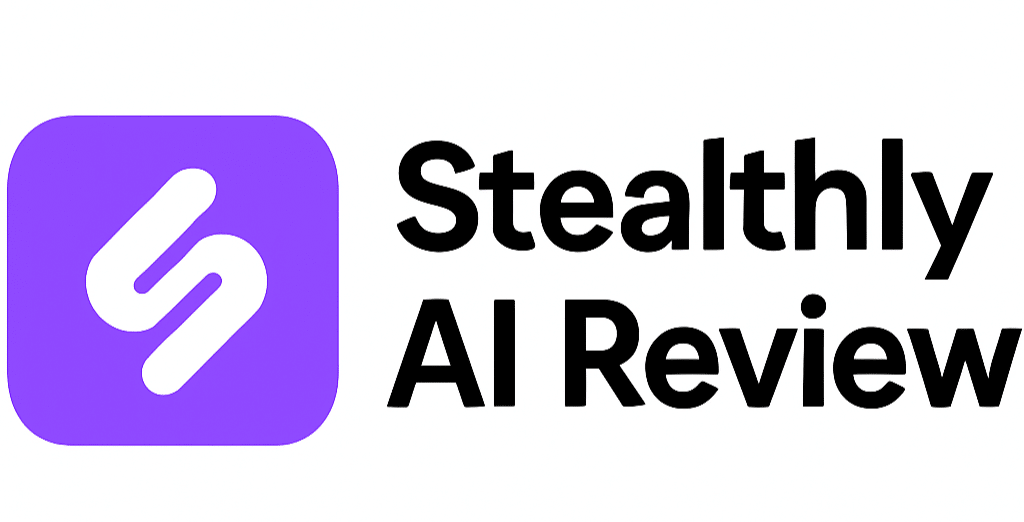
Writing has changed and I don’t mean in the areas of sentence structuring, punctuation rules, and everything else that rocks the writing process (though that has changed, too), but the way writing is read and structurally and semantically analyzed.
All this came to be with the rise of and reception to AI writers, who drastically reduced writing hours to save time. However, the results of using AI to write unfailingly accumulate to cliche phrases and look/sound-alike content everywhere. Unsurprisingly, institutions and hirers had to use AI detectors to push back on the usage volume just to enhance content quality. This has created a growing gap between the ease of AI writing and its believability.
To smooth things up, text humanizing tools emerged to rewrite AI-written content into something more natural, something that won’t raise flags. Because honestly, people won’t stop engaging AI writers anytime soon.
This review examines Stealthly AI’s features, highlighting what it does well, what it leaves out, and its place in comparison to other similar tools, including BypassGPT, HIX Bypass, Humbot AI, Undetectable AI, and AIHumanize.io. If you’re looking to use Stealthly AI effectively, this guide explains what to expect and how to use it properly.
So… what’s Stealthly AI?
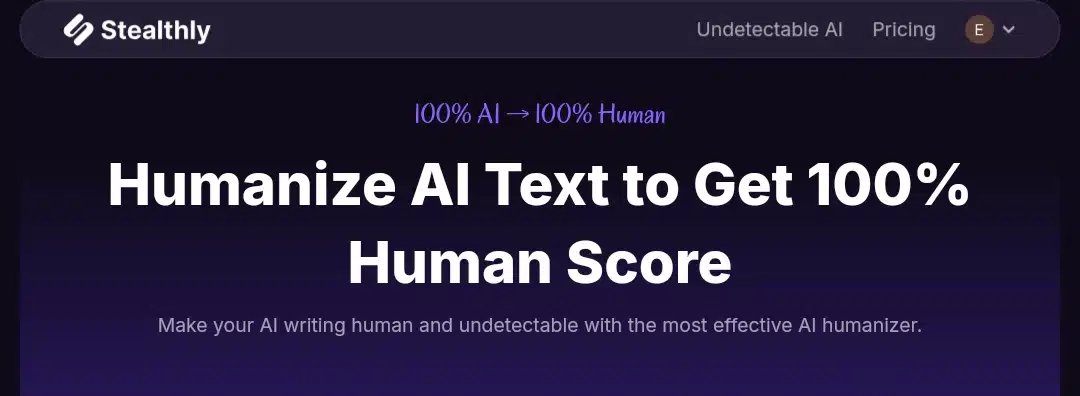
Stealthly AI is a highly specialized AI humanizer tool that transforms detectable AI-generated content into convincingly human text. Unlike basic paraphrasing tools, it uses deep learning models trained on over 10 million real-world texts, making it both context-aware and linguistically nuanced.
Stealthly AI’s ease-of-use, deep learning sophistication, and near-total undetectability make it one of the most capable AI humanizers currently available. Its effectiveness is backed by 96%+ success rates and over 700,000 users, all pointing to a tool built not just for rewriting, but for reliable, risk-free content transformation.
Who can use Stealthly AI?
Stealthly is best suited for users who already work with AI tools but need their content to pass human detection standards. These users often face restrictions, academic scrutiny, or platform penalties, and Stealthly helps bridge that gap. Some of the main user groups include the following:
Students and academic writers
Students using AI tools like ChatGPT for assignments, essays, or research papers often face detection from platforms like Turnitin or GPTZero. Stealthly helps them transform their AI-generated drafts into natural-sounding, undetectable writing that aligns with academic integrity standards.
Freelance writers and content agencies
Writers and editors working with AI-assisted drafts can use Stealthly to refine content into something polished and client-ready. It eliminates robotic tone, improves flow, and ensures the final text passes undetected through even advanced AI detectors, including Originality.ai.
Seo specialists and web writers
Google’s spam policies are evolving to penalize low-quality AI content. Stealthly ensures that AI-generated articles are restructured in ways that appear fully human, helping sites avoid search penalties and maintain rankings.
Researchers and professionals
For technical writers, business analysts, or researchers who use AI to draft long-form content, Stealthly improves readability while preserving accuracy without raising red flags in publication or compliance reviews.
Basically, Stealthly AI serves anyone who wants their AI content to read, rank, and be received as if a real human wrote it. Now, let’s look at the features that effectively enable Stealthy AI.
What features does Stealthly AI have?
Stealthly AI is designed to transform AI-generated text that AI detectors might flag into content that appears to be written by a human. To achieve this, it uses advanced language models and smart rewriting methods. Every part of the tool is designed to make your content difficult to detect as AI-generated, preserve the original meaning, and ensure the writing flows naturally. The features below are what make Stealthly AI work so well:
Multi-level humanization modes
To meet a range of detection challenges, Stealthly provides three distinct rewriting modes:
Light Mode applies minimal edits, which is ideal when the AI-generated text already reads somewhat naturally.
Balanced Mode introduces moderate phrasing and structure changes while preserving the original flow.
Deep Mode executes a comprehensive rewrite, reconstructing both vocabulary and sentence structure to avoid detection by even the most sensitive AI detectors.
These modes give users control over how aggressively their content is rewritten, allowing for flexibility based on purpose and platform risk.
Detector-optimized rewriting
Rather than using generic paraphrasing tricks, Stealthly is purpose-built to bypass specific AI detectors. The system has been rigorously tested against:
- Turnitin
- GPTZero
- Originality.ai
- Copyleaks
- ZeroGPT
- Winston AI
- Sapling, among others.
By tailoring its outputs to account for each platform’s signal patterns, Stealthly increases the likelihood of consistently successful bypassing across varied use cases.
Context-aware AI detection
Before making changes, Stealthly analyzes the input to detect which sections are most likely to be flagged as AI-generated. This analysis is powered by internal models trained on more than 10 million AI and human writing examples. As a result, the tool rewrites with precision, only where necessary, optimizing both efficiency and outcome.
High-volume word processing
To support long-form use cases, Stealthly accommodates high word counts per session. Depending on the user’s subscription, the tool allows up to 2,000 words per request, with plans offering monthly capacities of up to 300,000 words. This makes it ideal for users who regularly process essays, articles, reports, or client content at scale.
Integrated error correction
Rewritten content isn’t just detector-safe, it’s also grammatically sound. Stealthly AI automatically corrects punctuation, grammar, and syntax errors during the humanization process. Unlike traditional grammar tools, this correction is woven into the rewriting logic, eliminating the need for manual cleanup afterward.
Multilingual compatibility
For users working across languages, Stealthly supports 16 languages, which include:
English, Spanish, French, German, Arabic, Japanese, Chinese (Simplified and Traditional), Russian, Korean, Thai, Turkish, Portuguese, Dutch, and others.
This multilingual capability expands its usefulness beyond English-speaking environments and makes it a practical choice for global teams, translators, and international publishers.
Anti-plagiarism rewrite engine
Finally, Stealthly goes a step further by ensuring that all outputs are plagiarism-free. The system doesn’t simply reword content; it reconstructs it at a deep level, making each output structurally unique. This allows users to pass originality checks, including Turnitin, without relying on superficial paraphrasing that often fails under scrutiny.
So are these free or come with a price tag, and if yes, how much? Let’s find out in the following subsection.
Stealthly AI pricing
Stealthly AI offers a tiered pricing model ranging from a free plan to robust paid subscriptions. It’s competitively priced, especially on annual billing, where discounts go as high as 59%. The standout feature across all plans is access to a trillion-parameter language model and three unique humanization modes. Here’s a breakdown:
| Plan | Monthly Cost | Yearly Cost | Annual Savings | Word Limit | Words/Request | AI Detector Words | Key Features |
| Free | $0.00 | $0.00 | – | 300/month | 80 | 300/month | • Basic AI detection• Bypass basic detectors• No advanced features |
| Basic | $17.00 | $11.00 | $72/year | 20,000/month | 400 | 50,000/month | • All Free features• Higher word limits• Still no strictest detector bypass |
| Premium(Recommended) | $49.00 | $20.00 | $348/year | 300,000/month | 2,000 | 500,000/month | • Bypass strictest AI detectors• No plagiarism issues•Error-free outputs• Original meaning retained• Priority support |
| Pro | $30.00 | $20.00 | $120/year | 50,000/month | 1,000 | 100,000/month | • All Premium features• Mid-tier word allocation• Full detector bypass |
If you’re choosing between plans, the Premium Plan (Yearly) stands out as the best value:
- $20/month when billed annually
- Saves $348/year compared to monthly billing
- Highest word and AI detector limits
- Full access to the strictest AI bypass features
- Priority support and enhanced accuracy tools
The Premium plan offers 6x more words for regular users than the Pro plan at the same yearly or monthly rate, making it the most cost-effective choice for high-volume AI content refinement.
How to sign up for Stealthly AI and test its AI text humanizing features
To begin testing Stealthly AI, I used the Chrome browser on my phone and searched for “Stealthly AI” in the address bar. The tool appeared as the first result, and I tapped it to access the official homepage. I immediately noticed that signing up or logging in was not required to use the basic functions; the interface was open and accessible immediately.
However, I still chose to sign up to explore all available features. On clicking “Sign Up,” I was presented with two options:
- Manually enter an email address and password
- Or sign in with Google
I opted for the Google sign-in, which was completed in under five seconds. Even before signing in, I could interact with the interface, but registration allowed for smoother navigation and potentially more consistent access to full functionality.
Once signed in, I was taken to the main dashboard. The layout featured two main boxes:
- One for pasting AI-generated content
- Another where the humanized version would appear
Alongside these was a prominent ribbon menu underneath the input box, allowing users to select the specific type of content they want to humanize. This ribbon lets users guide the rewriting process by specifying the purpose or context of the text. The available content types in the ribbon include:
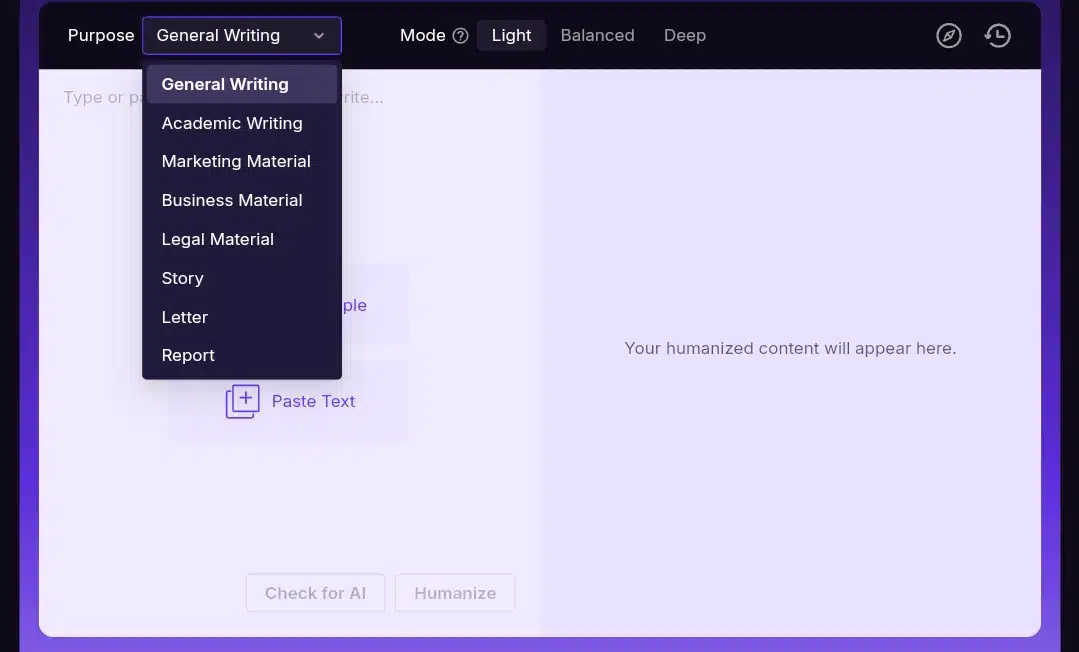
- General writing (default)
- Academic writing
- Marketing material
- Business material
- Legal material
- Story
- Letter
- Report
By default, the tool is set to “General Writing,” but selecting a more specific category like “Marketing” or “Legal” adjusts the tone and structure of the output accordingly.
In addition to the writing categories, Stealthly AI allows users to control how deeply the text should be humanized. This is managed through a “Mode” selector, positioned above the input box. The three available mood settings are:
- Light – for minimal edits that retain most of the original structure
- Balanced – a moderate rewriting that aims to preserve meaning while improving flow
- Deep – the most transformative setting, which significantly rewrites the input to avoid detection
These mode levels allow users to choose the intensity of humanization depending on their use case — whether they just need light re-edits or complete structural changes.
Right below these mood settings is another helpful feature: Check for AI. After pasting content into the input box, users can tap this option to analyze how AI-like the content is. The system provides a confidence rating to show whether the input text is likely AI-generated or not. This check can be run before humanizing, helping users decide if rewriting is necessary.
Once a user chooses to proceed, they simply tap the “Humanize” button to generate the new text version. The resulting content appears in the output box to the right.
In terms of layout, here’s how the Stealthly AI interface is organized:
- The ribbon (writing type) and mood settings are positioned above the AI-generated input box
- The AI Detection and Humanize buttons are located below the input box
- The rewritten (humanized) content appears on the right side of the screen
This layout makes it easy to follow a natural top-to-bottom and left-to-right workflow: paste → check → select mode → humanize → review output.
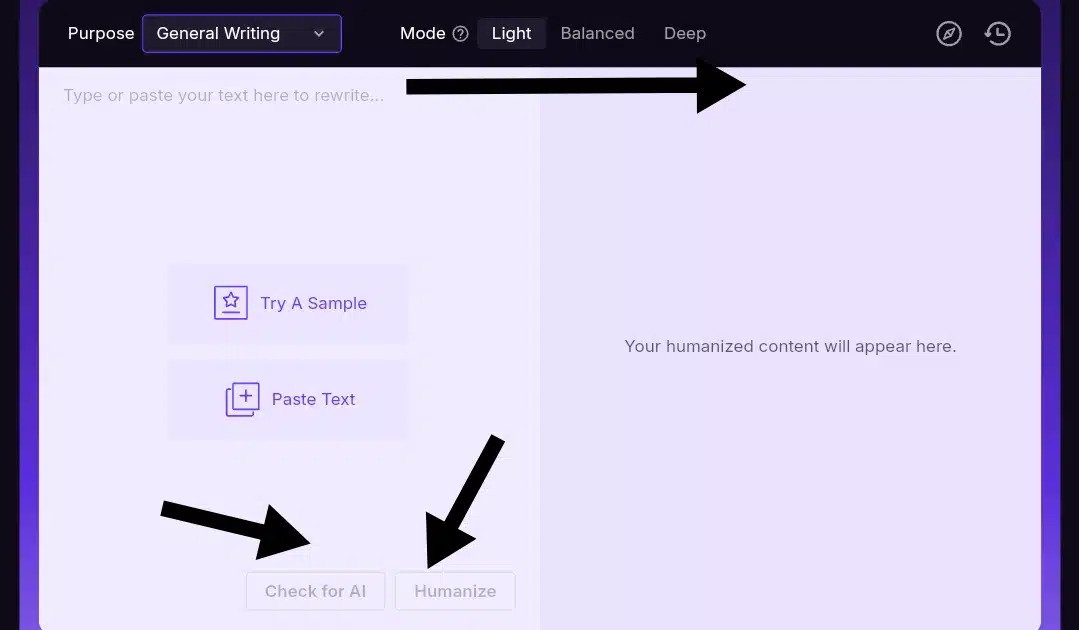
To properly test how Stealthly AI would humanize a short story, I began by asking ChatGPT to write one. Since ChatGPT is known for generating flash fiction quickly, I gave it a prompt:

It returned a 100-word story, but when I pasted it into Stealthy AI’s input box, I received an alert that the story exceeded the tool’s word count limit of 80 words for free users.

To stay within the limit, I returned to ChatGPT and asked it to shorten the story to exactly 80 words. Once I had the shorter version, I pasted it into the Stealthy AI input box and proceeded with the test.
Before humanizing the content, I tapped the “Check for AI” feature. This function analyzes how likely the text is to be AI-generated. The result returned 72% as human, which was not high enough to feel confident about passing stricter AI detectors.
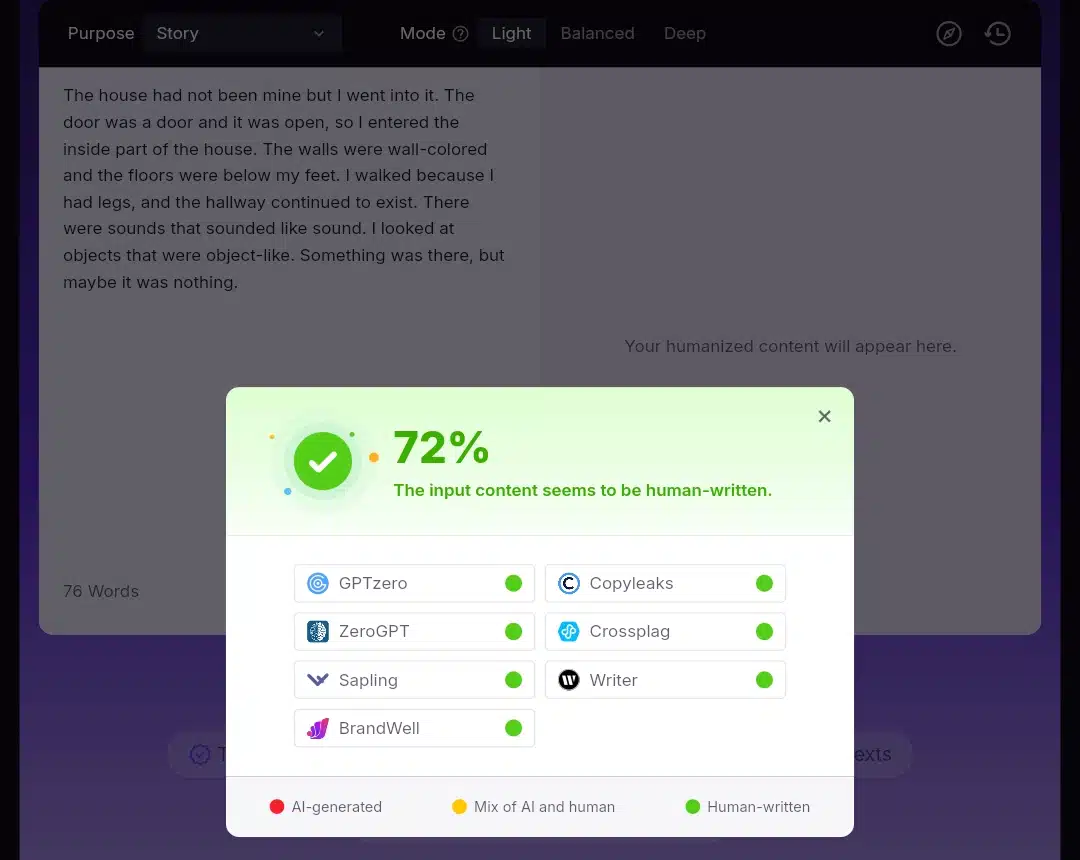
In my experience, anything below 90% often raises doubts, especially when submitting content to platforms that use aggressive detection models.
I then tapped the “Humanize” button. The output appeared in the box on the right, and the word count of the humanized version had increased to 111 words. I ran another detection check, and this time, it was marked as 77% human-generated.

It was an improvement, but still lower than I had hoped. Ideally, I expected something much closer to 100%, or at least high enough to feel secure.
The result left me unsure. On one hand, the rewrite seemed more natural, but on the other, the score still fell short of being convincingly human.
To better understand humanization’s effectiveness, I tested the output across ZeroGPT, an external AI detector. I did this to see whether the content Stealthly AI had rewritten would be rated as more human-like by this independent tool or if the detectors would still flag it as likely AI-generated.
If ZeroGPT showed a significantly higher “human” score than the original, it would mean Stealthly AI had done a decent job. But if the scores remained low ( or even dropped ), it would question how much value the humanizer actually adds.
The result was disappointing; it returned a verdict of 100% AI-generated.
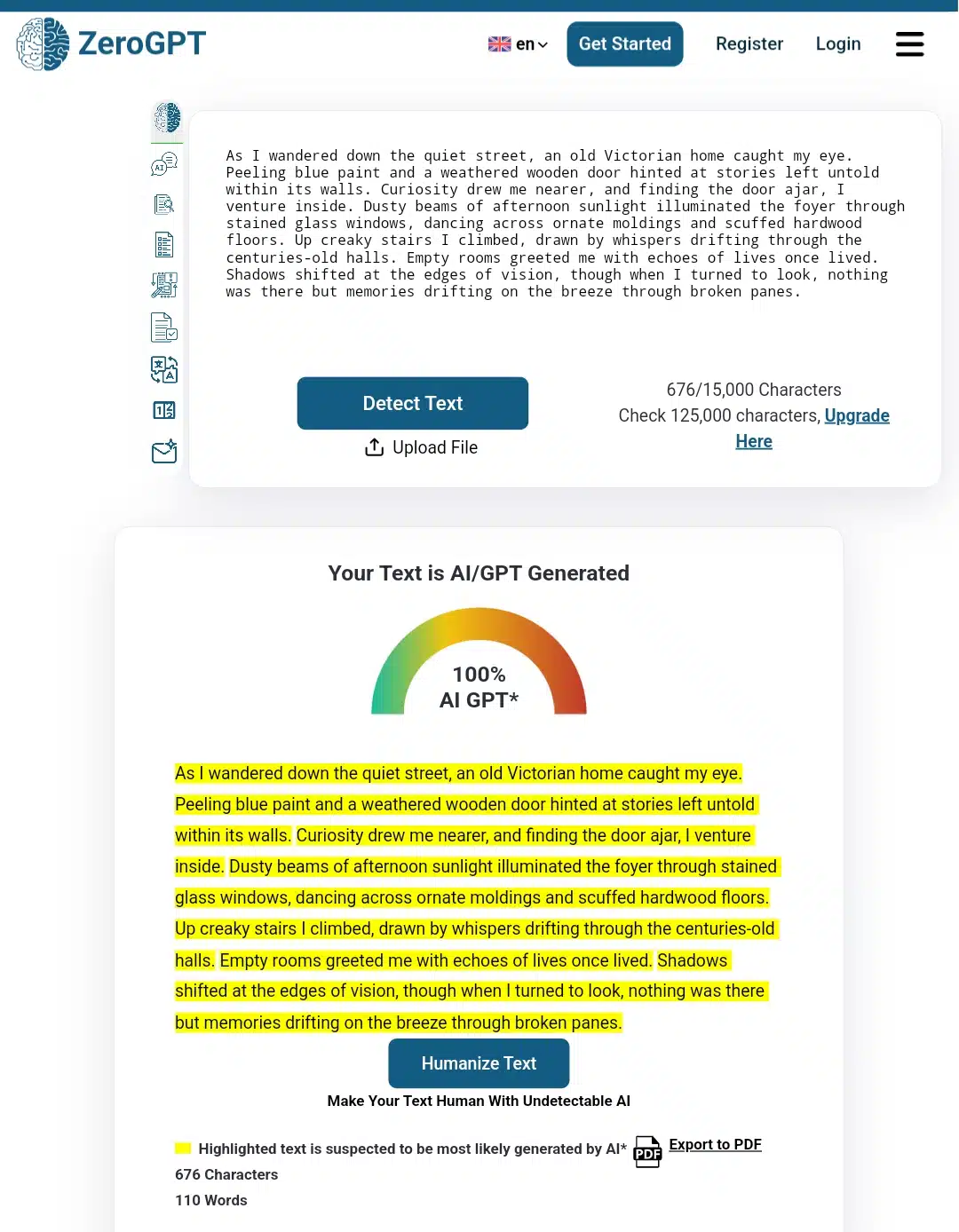
This was concerning. If a tool designed to make AI content sound human still produces output that triggers a perfect AI detection score, it raises questions about how effective the rewrite actually is. On the surface, the language looked slightly more natural, but structurally and stylistically, something in the text still felt machine-written, at least to ZeroGPT.
Naturally, this made me question whether Stealthly AI is truly effective for story-based writing, or if storytelling is simply not its strength. Some tools perform better in specific niches (for example, academic or business rewriting) and fall short in others. So, instead of giving up, I shifted focus and tested the tool again, this time using a different writing category.
For the next test, I selected “General Writing” from the ribbon menu and chose a completely different topic. I wanted to see whether Stealthly AI could handle a short paragraph that wasn’t narrative-based, something more in the area of informational or marketing copy, where it might have a better chance at producing text that feels authentically human.
The results became even more confusing after running the general writing sample through Stealthly AI. When I pasted the original 80-word marketing paragraph into the tool and used the “Check for AI” feature, it returned a 78% human score, which was not perfect but decent. However, once I clicked “Humanize” and re-checked the rewritten version, the score dropped to 57%, meaning the tool had actually made the text look more AI-written according to its own metrics.
Curious, I copied the humanized version and tested it again using ZeroGPT. Like before, it returned 100% AI-generated, the same disappointing result I had seen with the story-based content. At this point, I seriously questioned the reliability of Stealthy AI’s humanizer.
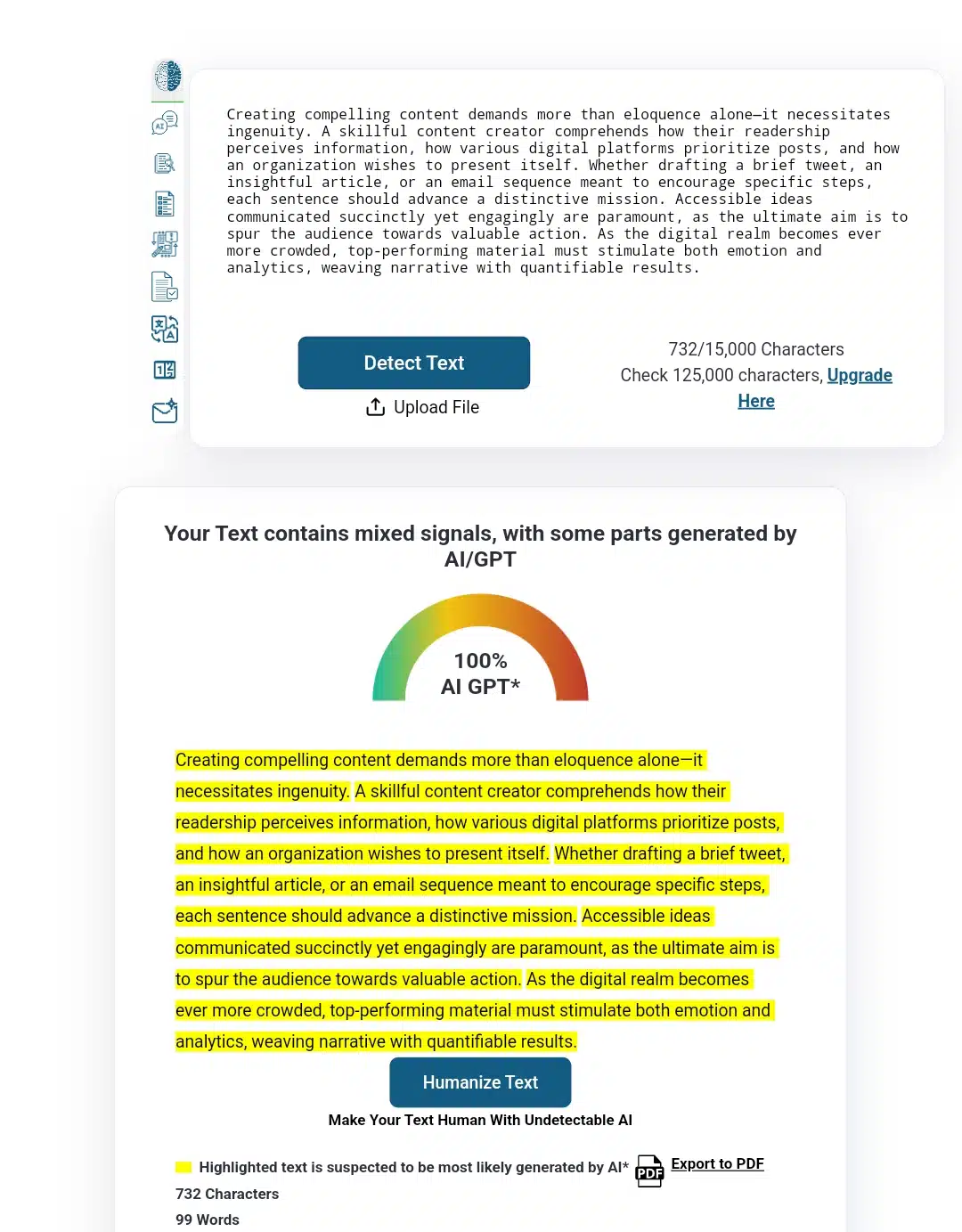
Even though I was using the free version, I expected at least a basic level of improvement. But I experienced the opposite: the tool sometimes made the content worse. Based on these tests, I don’t think I would ever consider paying for the full version. If this is the best it can do without a subscription, then it’s hard to imagine how anyone would feel confident enough to invest money in it. The risk of detection is simply too high.
Stealthy AI pros and cons
After testing Stealthly AI across different content types and detectors, I left with mixed impressions. The tool has a few promising features, but also falls short in several key areas that matter most when trying to bypass AI detection systems.
Pros
No login required to start
Stealthly AI enables users to interact with its interface without requiring a login or sign-up. That accessibility is convenient for people who want to quickly test the tool without creating an account or sharing their data. Even after logging in, the transition was easy and fast; signing in with Google took less than five seconds.
Clean and organized interface
The layout is well-structured. There are two clearly separated boxes: one for input and one for output. The ribbon menu above the input box is helpful, letting you choose the tone or writing category (e.g., General, Academic, Legal, etc.). The mood selector (Light, Balanced, Deep) gives the impression of flexibility in how heavily the content should be rewritten.
Built-In AI detection check
Before deciding whether to humanize your content, you can use the “Check for AI” feature to see how likely your input will be flagged as AI-generated. This is helpful for users who want to assess whether rewriting is necessary. It’s also nice that the tool displays its own estimation of how “human” the content is after humanization.
Fast processing time
Despite the underwhelming results, the tool itself runs quickly. When it works, it delivers rewritten text almost instantly without glitches or waiting times, which makes testing faster and more fluid.
Cons
Weak humanization results
The most important function(making AI content more human-like) wasn’t delivered. In both of my tests (a short story and a general marketing paragraph), the humanized output was still flagged as 100% AI-generated by ZeroGPT. Worse, the tool’s internal “human score” dropped after humanizing, suggesting the rewrite may have introduced even more detectable AI patterns.
Inconsistency between internal and external scores
There’s a noticeable disconnect between Stealthly AI’s own detection system and independent tools like ZeroGPT. The internal score might say 77% human, while ZeroGPT calls the exact text 100% AI. That inconsistency makes it hard to trust any improvements shown inside the platform.
Word count limitations
On the free version, users are limited to 80 words per input, which is very restrictive. It forces you to split up longer pieces unnaturally or stick to tiny samples that don’t fully reflect real-world writing use cases. This also limits how well you can evaluate its performance across extended content.
No evidence that a premium is better
While I tested only the free version, the experience didn’t inspire enough confidence to consider upgrading. Suppose the core rewriting engine performs this poorly under basic conditions. In that case, I can’t reasonably assume that the paid version would produce drastically different results, especially when the platform fails at even simple tasks like fooling a basic AI detector.
Not Niche-Adaptive
Some AI humanizers adapt better to different content types. For example, Stealthly AI showed no signs of such adaptability during the General writing vs. story toggle. So even though I used a narrative passage or informational writing, the results remained underwhelming.
5 top Stealthly AI alternatives
Here are 5 other top humanizers to work with if you want to engage more than Stealthly AI. They’re as follows:
Undetectable AI

Undetectable AI is a dual-purpose tool designed to detect AI-generated content and convert it into human-like writing. It’s widely recognized, rated highly by Forbes and Business Insider, and trusted by over 18 million users globally. It supports detection across dozens of models (GPT-3.5, GPT-4, Claude, Gemini, QuillBot, etc.) and offers robust humanization tools suitable for students, SEO professionals, and researchers.
Features
Real-time AI detection using multiple detectors in one scan
Built-in AI Humanizer for flagged content
Supports up to 10,000 characters per check
Free AI Detector with Chrome Extension
Multi-language detection and rewriting (50+ languages)
Trusted by 19M+ users and reviewed by Forbes, BuzzFeed, and Business Insider
Detects both direct AI content and paraphrased versions
Optimized for school, work, SEO, and editorial use
Undetectable AI pricing
Undetectable AI offers flexible monthly and yearly options. The monthly plan costs $19/month and includes 20,000 words. If you choose the yearly plan, you pay $60/year, which breaks down to just $5/ per month, offering a 50% discount. Both plans include unlimited AI detecting, watermark-free rewriting, access to Smart Job Applier, and API compatibility. There’s also a custom business plan with non-expiring credits and white labeling options for teams that need bulk usage. This plan is tailored per request and includes priority support.
Humbot AI
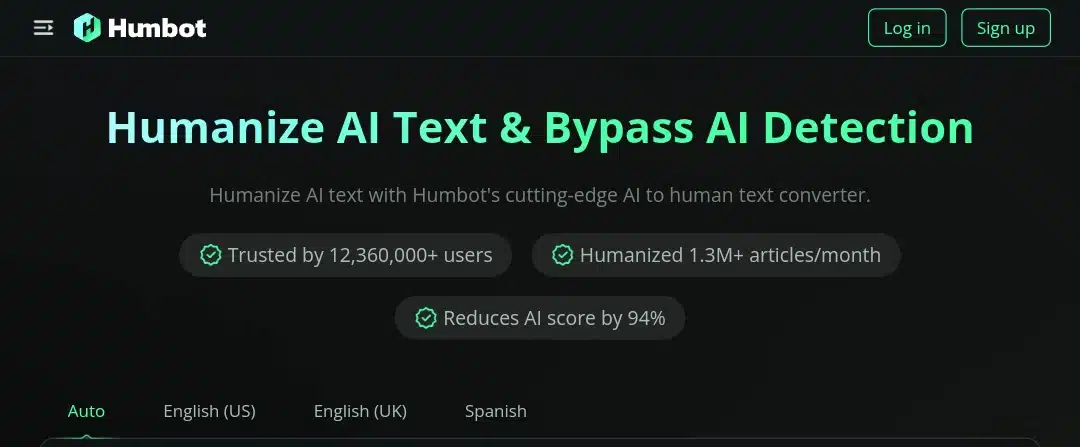
Humbot AI is a trusted AI-to-human converter used by over 12 million users worldwide, humanizing more than 1.3 million monthly articles. Built on top-tier large language models (LLMs) with billions of parameters, users can paste or upload AI-written content and receive rewritten, grammatically clean, original, and undetectable humanized outputs.
Features
Rewrites AI text to reduce detection scores by up to 94%
Supports over 50 languages, including English, Spanish, French, Japanese, Arabic, and Chinese
Optimized to bypass major detectors like Originality.ai, GPTZero, Turnitin, QuillBot, and Copyleaks
Offers mode options like Academic, Expand, and Shorten
Displays side-by-side examples of AI vs humanized text for clarity
Built on high-parameter LLMs that ensure deep and natural rewriting
Rewritten text is error-free, grammatically correct, and plagiarism-resistant
Includes upload support for text files, not just paste-in content
Free plan available for testing before upgrade
Data is encrypted and processed with strict privacy compliance
Humbot AI pricing
Humbot AI has flexible pricing options. The Free plan gives 600 words/month with basic rewriting features. Paid plans start at $11.99/month (or $7.99/month billed yearly) for 3,000 words. The Pro plan is $22.99/month (or $9.99/yearly) for 30,000 words and includes an advanced AI detector bypass. The Unlimited plan is $59.99/month or $9.99/month billed yearly for unlimited usage. There’s also a One-Time option at $9.99 for 2,000 total words.
BypassGPT AI
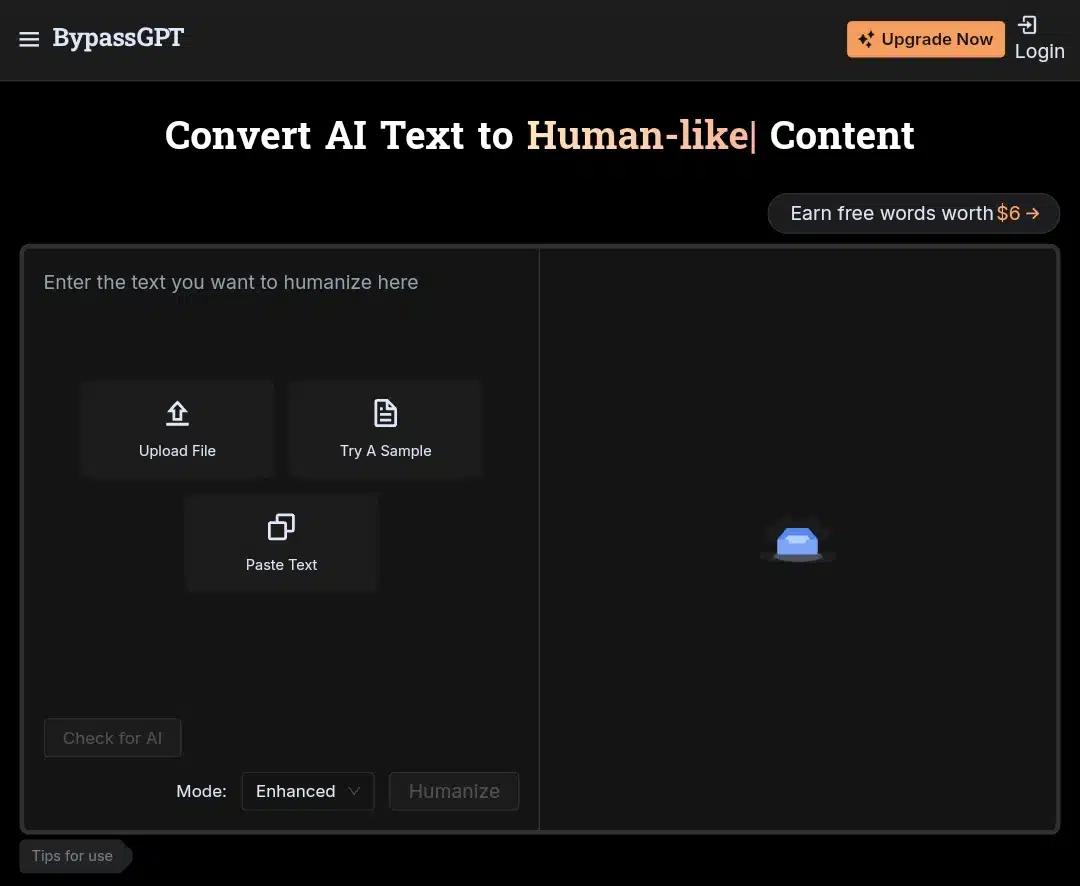
BypassGPT AI is an AI humanizer and bypassing tool trusted by over 10 million users worldwide. It’s trained on more than 200 million examples of AI and human-generated content, giving it precise recognition of converting robotic text into undetectable human-style writing. The tool can rewrite AI content in over 50 languages, producing error-free, unique, and SEO-optimized outputs ready for academic, marketing, or publishing use.
Features
100% Undetectable AI text rewrites
Plagiarism-free outputs, suitable for academic and professional use
Fixes grammar, syntax, and punctuation errors automatically
Built-in SEO enhancements to help content rank on Google
Supports over 50 global languages, including English, Spanish, Arabic, Japanese, and Swahili
Optimized to bypass all major AI detectors, including Originality.ai, GPTZero, Copyleaks, and Turnitin
Simplified 3-step process: Paste, Click, Receive
Rewrites content while maintaining original meaning and engagement
Built on a model trained with 200M+ data points
Offers free usage with optional upgrades
BypassGPT AI pricing
BypassGPT AI offers four monthly plans: a Free tier with 150 words/month, Basic at $12/month for 5,000 words, Pro at $35/month for 30,000 words, and Unlimited at $39/month. All plans include three rewriting modes (Fast, Creative, Enhanced), support for major AI detectors (like GPTZero and Copyleaks), plagiarism-free output, and encrypted rewriting. With current flash sale discounts, Unlimited drops to $19/month and Pro to $15/month, making it one of the most affordable humanizers at scale.
AIHumanize.io

AIHumanize.io is designed to make AI-generated content sound more human, helping users create natural, fluent, and authentic writing. Focusing on tone and flow, the tool rewrites AI content to better reflect human expression. Writers, marketers, and students rely on AIHumanize.io to refine AI drafts into smoother, more readable material that blends effortlessly into real-world contexts.
Features
100% AI detector bypass supporting Turnitin, GPTZero, Copyleaks, ZeroGPT, Quillbot, and more
Scene-based humanization that rewrites in academic, blog, or business tone with one click
Multiple versions per rewrite, allowing you to choose the most natural output
Supports all rewrite styles, including academic, general, conversational, and professional
Private rewriting model that gives each user a secure rewriting environment
Word count options that go up to 3,000 words per request on higher-tier plans
SEO-friendly output that is optimized for readability and search engine visibility
Usage history that allows you to view and reuse previously rewritten content
Global language support in 20 languages, including English, Chinese, Spanish, Arabic, and other languages
AIHumanize.io pricing
AIHumanize.io offers three monthly plans: Basic at $15 for 15,000 words, Pro at $25 for 50,000 words, and Unlimited at $40 for unlimited rewriting. Each plan includes features like Autopilot Pro mode, view history, and private rewriting. Yearly discounts bring prices down to $6 per month (Basic), $10/month (Pro), and $20/month (Unlimited).
HIX AI
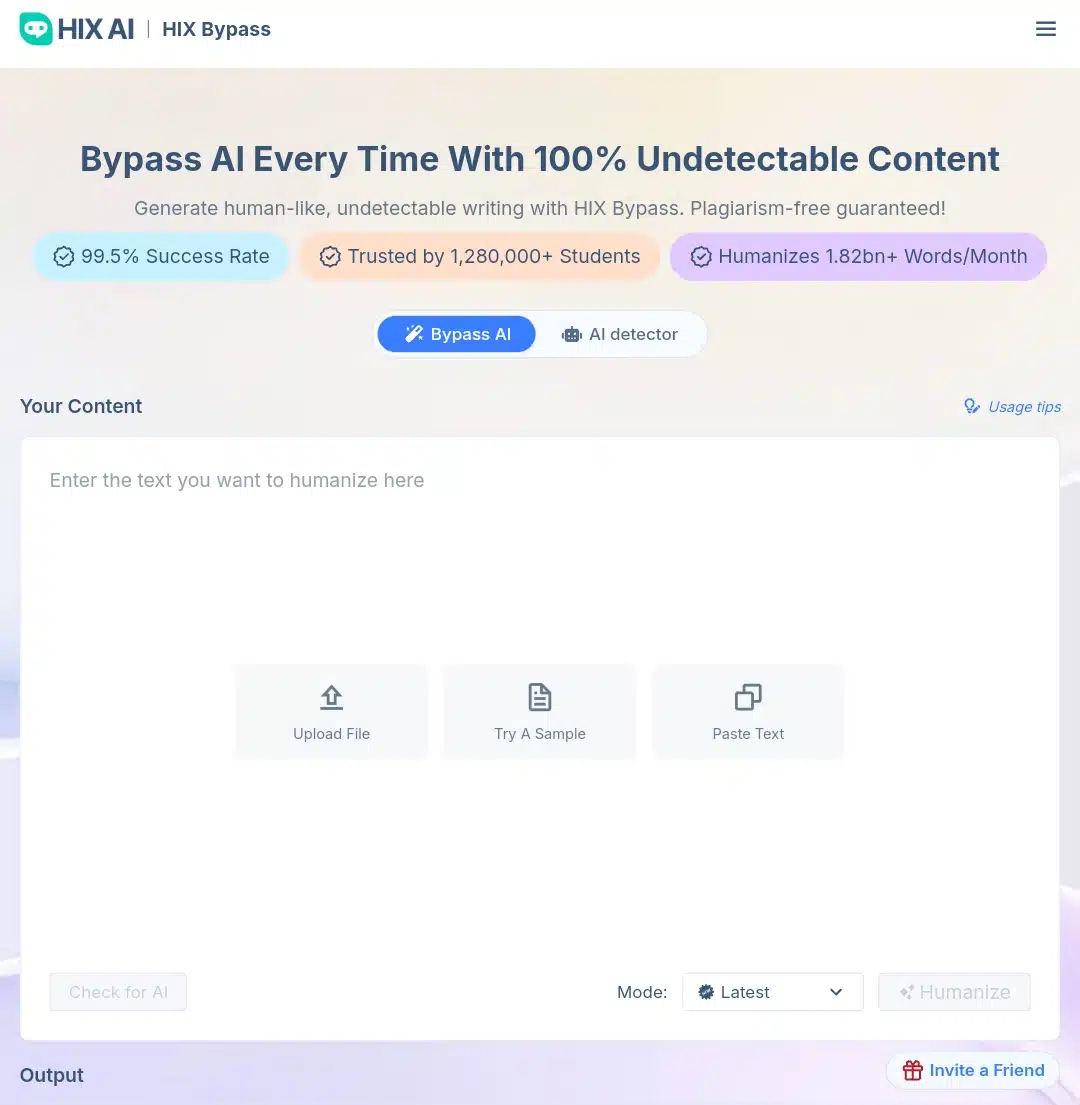
HIX bypass AI is built to help users transform AI-generated writing into content that reads naturally and escapes detection by AI tools. It focuses on producing clean, believable human-like text that aligns with how real people write. Ideal for a wide range of use cases, it’s often chosen by users who want dependable results without overcomplicating the process. Whether for publishing, academics, or professional writing, HIX AI offers a seamless and effective solution for confidently rewriting AI content.
Features
It’s a real-time AI detector scanning, validating rewritten content directly within the tool
It has four rewriting modes, so you can choose Fast, Balanced, Aggressive, and Latest for deeper rewording
It bypasses all major detectors like GPTZero, Copyleaks, ZeroGPT, Originality.ai 3.0, Winston AI, and more
It has built-in language detection and multi-language support of over 50 languages, including Arabic, Hindi, Japanese, and French
Generates clean, undetectable, and original writing
It removes ChatGPT traces and system prompts
It has API Access for Businesses, so one can integrate HIX Bypass directly into enterprise workflows
It’s trained on trillions of parameters, so it uses advanced LLMs for natural output
It maintains clarity and tone without damaging intent
HIX AI Pricing
HIX AI offers three pricing tiers: Basic, Pro, and Unlimited. The Basic plan is $14.99/month or $9.99/month when billed yearly (5,000 words/month). The Pro plan costs $29.99/month or $14.99/month yearly (50,000 words/month, 2,000 words/request). The Unlimited plan is $59.99/month, but drops to $15/month with annual billing. All plans have access to multiple rewriting modes, 50+ language support, built-in AI detectors, and bypass capability for advanced tools like Originality.ai 3.0. You also get ChatGPT watermark removal and no-distortion humanization on every plan.
Stealthly AI’s top 5 alternatives compared
| Tool Name | Free PlanMax Words | Monthly Price Range | Yearly Price Range | Max Words (Monthly) | Detector Bypass Support | Key Highlights |
| Undetectable AI | Not stated on the homepage | $19 | $5/month (billed $60/year) | 20,000 words | Yes – All major detectors | Dual-use (Detector + Rewriter), API access, watermark removal |
| Humbot AI | 600 words | $11.99 – $59.99 | $7.99 – $9.99 | Unlimited (on the highest plan) | Yes – Advanced detectors on Pro+ plans | 1.3M+ articles/month, side-by-side rewrite view, multiple languages |
| BypassGPT AI | 150 words | $12 – $39 | $8-$19 | Unlimited (on the highest plan) | Yes – Full coverage of GPTZero, Copyleaks, Turnitin | Trained on 200M+ data, free plan available, SEO-friendly |
| AIHumanize.io | $15 – $40 | $6 – $20 | Unlimited (on the highest plan) | Yes – Supports 100–200 credits/month | Autopilot Pro, private rewrite model, multiple output versions | |
| HIX AI | Not stated on the homepage | $14.99 – $59.99 | $9.99 – $15 | Unlimited (on the highest plan) | Yes – Even bypasses Originality.ai 3.0, Winston AI | 4 rewrite modes, ChatGPT trace removal, trained on trillions of params |
You are privy to robust rewrite limits, up to unlimited requests, depending on the plan.
So, how good is Stealthly AI in humanizing AI-generated content, and should you try it?
After testing Stealthly AI across both storytelling and general writing tasks, the results were underwhelming. Despite its clean interface, writing modes, and built-in AI checker, the tool consistently failed at its core ability of making AI-generated content undetectable. In both test cases, the rewritten outputs were still flagged as 100% AI-generated by ZeroGPT. In fact, Stealthly AI’s own “Check for AI” feature sometimes returned lower human scores after the rewrite. While the tool may offer more under a paid plan, the free version doesn’t inspire the confidence needed to justify an upgrade.
If you’re looking for more reliable results(especially when detection matters), Stealthly AI may not be the best option right now.
Instead, consider trying out one of these 5 top Stealthly AI alternatives. I would recommend Humbot AI and Undetectable AI most. They offer better rewriting accuracy, stronger detection evasion, and more consistent real-world results.
Frequently Asked Questions (FAQs) about Stealthly AI
What makes Stealthly AI different from standard paraphrasers?
- Unlike basic tools that swap synonyms or rearrange words, Stealthly AI uses deep rewriting informed by specific AI detector patterns, restructuring sentences to mimic human expression, not just changing vocabulary.
Does Stealthly AI work with academic citations or references?
- Yes. While it rewrites your text, it respects citation formats (like APA or MLA), preserving footnotes and reference sections without altering citation integrity.
Can Stealthly AI humanize code comments or technical documentation?
- No. It cannot adapt to domain-specific language, so it can’t refine comments or documentation while maintaining technical accuracy and clarity.
How does Stealthly AI’s detector score influence humanization?
- Before rewriting, the built-in detector estimates how likely the input is AI-generated. That score helps guide how aggressively the humanizer applies Light, Balanced, or Deep mode, but the rewriting engine ensures undetectability.
Is there a way to preview changes before committing to a rewrite?
- Yes. Stealthly provides a side-by-side preview showing you the original text and the rewritten version, so you can compare changes before finalizing the output.
Can I maintain formatting and bullet lists through humanization?
- Yes, Stealthly preserves basic formatting, including bullet points, numbered lists, and headings. It rewrites content without stripping out structure or layout.
Are images, tables, or embedded media affected?
- No. Only plain text is processed. On Stealthly, embedded images, tables, links, or videos are left untouched, keeping your layout intact.
Does Stealthly AI learn from my past inputs?
- No. It does not retain or personalize based on your previous content. Each session is stateless, meaning your text isn’t stored or used to train future humanizations ensuring privacy.
Can I humanize batch files in one session?
- If you have multiple documents, you can combine them into one input (up to the word limit) or humanize each separately in sequence. There’s no bulk upload feature yet, but processing multiple texts in one submission works fine.
Does Stealthly offer team or enterprise collaboration tools?
- Yes. Higher-tier plans include team-based dashboards with shared word-credit pools and collaborative access. That lets writers and editors work from the same word allocation and review each other’s humanized outputs.










